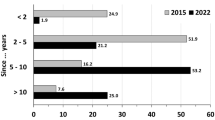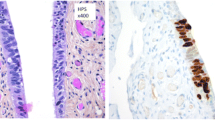Abstract
The detection of premalignant cells in the epithelium of the fallopian tube has resulted in revolutionary theories regarding the origin of epithelial ovarian cancer (EOC). Serous tubal intra-epithelial carcinomas (STIC) have been detected in patients with BRCA 1 or 2 mutations and are considered as the most likely precursors of the high-grade serous ovarian cancer (HGSOC), which is the most common histological subtype in patients with EOC. A bilateral salpingo-oophorectomy is associated with a significant reduction in risk of developing EOC. According to various national guidelines, prophylactic bilateral salpingo-oophorectomy should be performed in the age group 40–45 years. As in patients with BRCA mutations, the prophylactic removal of the fallopian tubes is also performed in women without an increased genetic risk, for example, in surgical treatments of benign conditions. There is a current debate as to whether prophylactic or so-called opportunistic salpingectomy will influence the overall incidence of EOC in the coming years. Opponents of this theory warn of a higher surgical morbidity and the higher risk of a premature menopause through impaired vascular supply to the ovaries. The value of opportunistic salpingectomies has not yet been clarified since there are currently no systematic risk–benefit evaluations. This review will attempt to give an overview of the current body of evidence regarding the risks and benefits of opportunistic salpingectomies.
Similar content being viewed by others
References
Fathalla MF (1971) Incessant ovulation—a factor in ovarian neoplasia? Lancet 2(7716):163
Cramer DW, Welch WR (1983) Determinants of ovarian cancer risk. II. Inferences regarding pathogenesis. J Natl Cancer Inst 71(4):717–721
Bell DA, Scully RE (1994) Early de novo ovarian carcinoma. A study of fourteen cases. Cancer 73(7):1859–1864
Shih Ie M, Kurman RJ (2004) Ovarian tumorigenesis: a proposed model based on morphological and molecular genetic analysis. Am J Pathol 164(5):1511–1518
Crum CP et al (2007) The distal fallopian tube: a new model for pelvic serous carcinogenesis. Curr Opin Obstet Gynecol 19(1):3–9
Piek JM et al (2001) Dysplastic changes in prophylactically removed fallopian tubes of women predisposed to developing ovarian cancer. J Pathol 195(4):451–456
Medeiros F et al (2006) The tubal fimbria is a preferred site for early adenocarcinoma in women with familial ovarian cancer syndrome. Am J Surg Pathol 30(2):230–236
Kindelberger DW et al (2007) Intraepithelial carcinoma of the fimbria and pelvic serous carcinoma: evidence for a causal relationship. Am J Surg Pathol 31(2):161–169
Folkins AK et al (2009) Precursors to pelvic serous carcinoma and their clinical implications. Gynecol Oncol 113(3):391–396
Powell CB et al (2011) Risk-reducing salpingo-oophorectomy (RRSO) in BRCA mutation carriers: experience with a consecutive series of 111 patients using a standardized surgical-pathological protocol. Int J Gynecol Cancer 21(5):846–851
Chivukula M et al (2011) Carcinomas of distal fallopian tube and their association with tubal intraepithelial carcinoma: do they share a common “precursor” lesion? loss of heterozygosity and immunohistochemical analysis using PAX 2, WT-1, and P53 markers. ISRN Obstet Gynecol 2011:858647
Paik DY et al (2012) Stem-like epithelial cells are concentrated in the distal end of the fallopian tube: a site for injury and serous cancer initiation. Stem Cells 30(11):2487–2497
Tang S et al (2012) Frequency of serous tubal intraepithelial carcinoma in various gynecologic malignancies: a study of 300 consecutive cases. Int J Gynecol Pathol 31(2):103–110
Bijron JG et al (2013) Fallopian tube intraluminal tumor spread from noninvasive precursor lesions: a novel metastatic route in early pelvic carcinogenesis. Am J Surg Pathol 37(8):1123–1130
Gao FF et al (2013) Clinicopathologic study of serous tubal intraepithelial carcinoma with invasive carcinoma: is serous tubal intraepithelial carcinoma a reliable feature for determining the organ of origin? Hum Pathol 44(8):1534–1543
Lee S et al (2013) Precursor lesions and prognostic factors in primary peritoneal serous carcinoma. Int J Gynecol Pathol 32(6):547–555
Reitsma W et al (2013) Support of the ‘fallopian tube hypothesis’ in a prospective series of risk-reducing salpingo-oophorectomy specimens. Eur J Cancer 49(1):132–141
Callahan MJ et al (2007) Primary fallopian tube malignancies in BRCA-positive women undergoing surgery for ovarian cancer risk reduction. J Clin Oncol 25(25):3985–3990
Przybycin CG et al (2010) Are all pelvic (nonuterine) serous carcinomas of tubal origin? Am J Surg Pathol 34(10):1407–1416
Jacoby VL et al (2011) Oophorectomy vs ovarian conservation with hysterectomy: cardiovascular disease, hip fracture, and cancer in the Women’s Health Initiative Observational Study. Arch Intern Med 171(8):760–768
Parker WH et al (2013) Long-term mortality associated with oophorectomy compared with ovarian conservation in the nurses’ health study. Obstet Gynecol 121(4):709–716
Rocca WA et al (2006) Survival patterns after oophorectomy in premenopausal women: a population-based cohort study. Lancet Oncol 7(10):821–828
Repasy I et al (2009) Effect of the removal of the fallopian tube during hysterectomy on ovarian survival: the orphan ovary syndrome. Eur J Obstet Gynecol Reprod Biol 144(1):64–67
Sezik M et al (2007) Total salpingectomy during abdominal hysterectomy: effects on ovarian reserve and ovarian stromal blood flow. J Obstet Gynaecol Res 33(6):863–869
Petri Nahas EA (2005) Effect of total abdominal hysterectomy on ovarian blood supply in women of reproductive age. J Ultrasound Med 24(2):169–174
Findley AD et al (2013) Short-term effects of salpingectomy during laparoscopic hysterectomy on ovarian reserve: a pilot randomized controlled trial. Fertil Steril 100(6):1704–1708
Dar P et al (2000) Ovarian function before and after salpingectomy in artificial reproductive technology patients. Hum Reprod 15(1):142–144
Vorwergk J et al (2014) Prophylactic bilateral salpingectomy (PBS) to reduce ovarian cancer risk incorporated in standard premenopausal hysterectomy: complications and re-operation rate. J Cancer Res Clin Oncol 140(5):859–865
Guldberg R et al (2013) Salpingectomy as standard at hysterectomy? A Danish cohort study, 1977–2010. BMJ Open 3(6). doi:10.1136/bmjopen-2013-002845
Kauff ND et al (2002) Risk-reducing salpingo-oophorectomy in women with a BRCA1 or BRCA2 mutation. N Engl J Med 346(21):1609–1615
Foulkes WD (2013) Preventing ovarian cancer by salpingectomy. Curr Oncol 20(3):139–142
Miller DM et al (2013) Opportunistic salpingectomy: the way forward-response to Steven Narod. Curr Oncol 20(3):143–144
Muller A et al (2010) Hysterectomy-a comparison of approaches. Dtsch Arztebl Int 107(20):353–359
Conflict of interest
The authors declare no conflict of interests.
Author information
Authors and Affiliations
Corresponding author
Rights and permissions
About this article
Cite this article
Pölcher, M., Hauptmann, S., Fotopoulou, C. et al. Opportunistic salpingectomies for the prevention of a high-grade serous carcinoma: a statement by the Kommission Ovar of the AGO. Arch Gynecol Obstet 292, 231–234 (2015). https://doi.org/10.1007/s00404-015-3697-y
Received:
Accepted:
Published:
Issue Date:
DOI: https://doi.org/10.1007/s00404-015-3697-y




